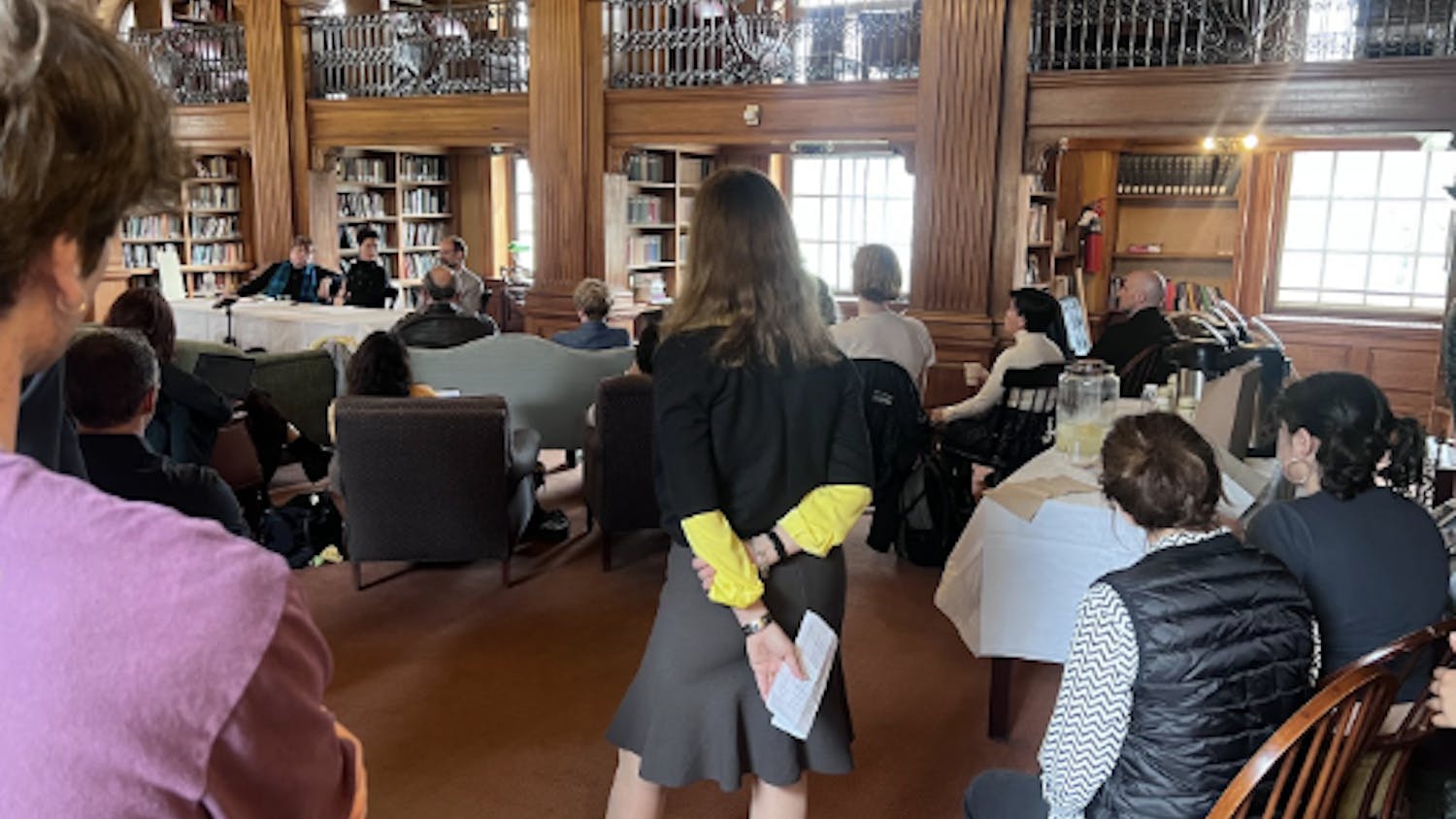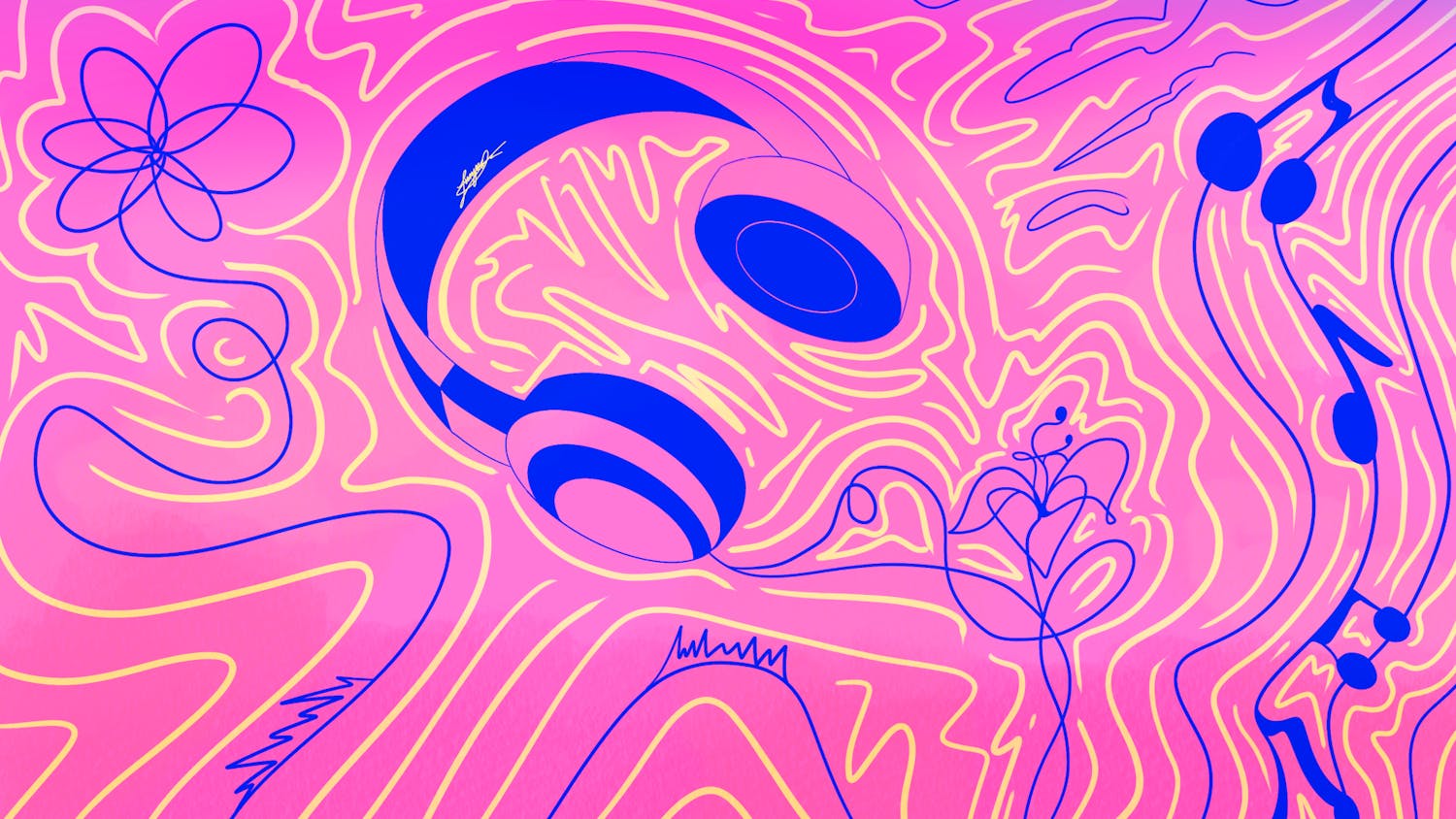On a rainy night, the middle of the Green is devoid of noise or activity save for some stragglers headed to their residence halls and the sound of rain on gravel. And then — a light flicks on in the distance. The previously empty rotunda at Hopkins Center glows under a warm lamp. In the space where during the day there was only a blank wall, is a painting.
The piece, titled “When We Go Home,” is part of Gabriel Barrios’ ’15 art exhibition. As one of the four interns for the studio art department who display their work in the rotunda at different parts of the year, Barrios is the first to have his art on exhibit for the public.
The exhibit will change depending on the time of day, Barrios said.“During the day, we have this empty wall, although there are nails attached to indicate that there should be something,” he said. “Come night time, around 11 p.m., I’ll come [to the rotunda] with the painting from my studio as I’m heading out for the night and hang it up, and I’ll come back at 7 in the morning to take it down and take it back to my studio.”
Gerald Auten, the department’s director of exhibitions, said that he found Barrios’ decision intriguing.
“It’s hard to see the rotunda from far away in the daytime, so to see it glowing at night is like seeing a lantern lit up from the Green,” he said. “The way the art is displayed reminds me of a section of an art museum I visited in Boston. Where the painting used to be is empty but the label’s still there — the painting is absent, just as it is in [Barrios’ exhibition]. It’s one example of how the art we display isn’t in a gallery, so it’s always interesting to see what the artist decides to do with the space.”
Barrios said that the decision to display his art late at night rather than during the day indicated both the creative context of his piece and his own reflection of the interaction between art and an audience.
“I think something about the way people interact with an [exhibit] that’s just in the middle of a typical place where people pass and come through reflects on what I don’t like about how paintings are interacted with normally, such as when you go to a museum and you stand for five seconds in front of a painting, if at all, and then you move onto the next one,” he said. “I find it impersonal when there’s too much of an open space, too much activity going on.”
Barrios said that he wanted his audience to have the chance to interact with his work alone to focus on one of its major themes — the act of being alone. He also said that he liked the way his piece looked in the darkness.
“I personally have always loved interacting with artwork alone,” he said. “In fact, a lot of my artwork tends to deal with how other people deal with being alone. So for me, it’s very important that if people do decide to interact with [my art], they do it in a setting where they are alone, such as walking back home alone at night, after studying [at Hopkins Center] or at Homecoming, after running around the bonfire. I think it also looks better at night, with the light shining on it and nothing much else going on outside.”
Barrios’s piece shows a figure of a boy upon a mostly empty background. He said that he was inspired by feelings of loneliness and isolation. He said that the figure itself was supposed to evoke those feelings.
“It’s meant to read more like a silhouette, when I had it in mind, of a small child in his early tens or so,” Barrios said. “When I was putting the paint down on the canvas, it built up so that there’s more of a layer on top of the background than within the figure itself. It should read kind of as if I’ve carved this figure into a white, yellow-ish space.”
He said that he was inspired by the idea of being not fully present at what was originally his home after his graduation.
“And I’ve realized going back home has become this bittersweet experience because I became aware of having lost something, in a way,” he said. “So with the painting, I wanted to make something that at least to me, reflected a similar kind of experience, that you’re constantly looking to [understand] this image that’s not necessarily always there, and doesn’t exactly give you a lot of information. It’s just this hollowed out kind of image, and you’re aware that there should be this boy there, but the thing that’s defined is the space that’s creating the boy, rather than the boy creating the space.”
Barrios said that both the figure and the painting’s title represented his experience as a college student visiting home after being away for certain amounts of time.
“I recently graduated, and over the years, it’s felt so strange to go home and see how much I’ve changed while going through college,” he said. “You’re aware of this fact that you are changing, and it’s never made as certain as it is when you go back home and everyone treats you the same, and everyone just forgets that you’re not the same person you were when you left."
Barrios said that the change he faced during his time at the College came from a growing interest in the studio arts.
Originally planning to study chemistry and biology and pursue the pre-med track, Barrios’ interest in the arts grew during a project he completed on an off-term where he and a co-partner decided to paint a school library with characters from books.
“I’d never painted before, but when I was painting Spider-Man, I thought, ‘This is pretty cool! Wouldn’t it be great if I could do more?’” he said. “And it became a free-time thing, taking that ‘Drawing 1’ course, and it just happened to work out with a lot of things that happened my sophomore fall, when I needed to do a lot of thinking with my hands. I just fell into it. It made sense to me.”
In his time spent in the studio art department, Barrios particularly credits professors Brenda Garand and Esmé Thompson for their encouragement and influence during his studies. He said that they both helped shape the work that he is currently doing.
As an intern, Barrios now works with the studio art department as a teaching assistant and in maintaining artwork and supplies.
“It’s just great to be on the other side of things, in a way, but still be close enough to be near the learning process and contribute my views to someone who hasn’t yet been able to approach a certain level of artistic development,” he said.
Lam said that Barrios began interning during the summer term, making him the most experienced of the interns. She described working with him as “amazing”.
“He makes our work fun, but he transitions to seriousness when we need to get things done,” she said. “He’s so full of warmth and support. He truly wants people to enjoy themselves.”
Barrios’ piece went on display on Sept. 18 and will remain up until Oct. 18.
Barrios’s piece went on display on Sept. 18 and will remain up until Oct. 18.



